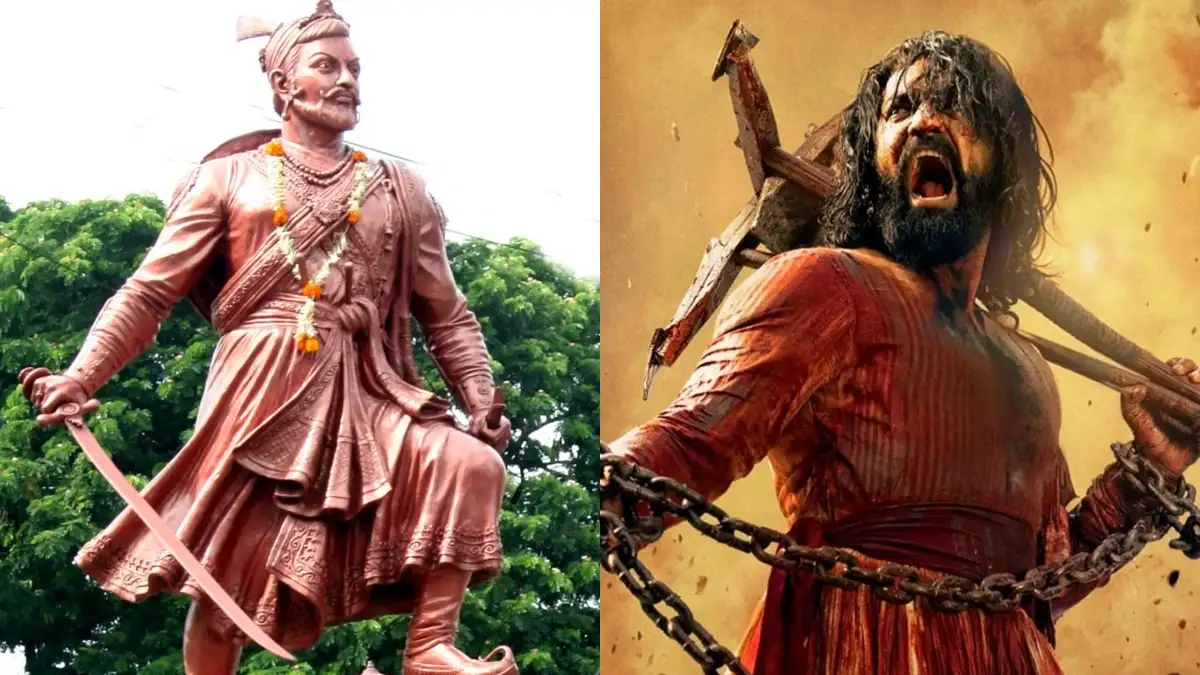
Bollywood’s period drama ‘Chhaava’ has been released on big screens. There is a discussion going on all over the country about the historical personality on which the story of this film is based. Many stories related to Chhatrapati Sambhaji Maharaj, who ruled the Maratha Empire for eight years after the death of his father Chhatrapati Shivaji Maharaj, have gone viral on social media. In such a situation, let’s have a look at the description found about Sambhaji in history books.
Early life
Sambhaji Raje was born on May 14, 1657 in the fort of Purandar, located about 50 kilometres from Pune in Maharashtra. He was the eldest of the two sons of Chhatrapati Shivaji Maharaj. Although Shivaji had eight marriages and most of these marriages were done for political purposes, from these eight marriages he had six daughters and two sons. The eldest son Sambhaji and younger son Rajaram had a difference of about 13 years in age.
Sambhaji Raje was the son of Chhatrapati Shivaji Maharaj and his first wife Saibai. When Sambhaji was two years old, his mother died and he was raised by his grandmother, Shivaji’s mother Jijabai. Shivaji Maharaj had hired many scholars for Sambhaji’s education. Also known as Chhaava, Sambhaji had a strong hold on Sanskrit due to his tremendous talent.
Sambhaji was married at the age of just 9 years
Chhatrapati Shivaji Maharaj made matrimonial alliances an important means to expand the scope of Maratha rule. In late 1664, he arranged Sambhaji’s marriage to the powerful Deshmukh family in the Tal-Konkani region of southwest Maharashtra. His wife Jeevubai alias Yesubai was the daughter of Pilaji Rao Shirke. This marriage helped Shivaji expand the Maratha empire to the Konkan region.
Rumours spread about bad behaviour
Viswas Patil’s book Mahasamrat and Kamal Gokhale’s book Shivaputra Sambhaji mention Sambhaji Maharaj’s later life. It is said that when Shivaji Maharaj was crowned in 1674, Sambhaji was considered certain to become his successor. However, during this period, several rumours about Chhaava were prominent. Some of this news was related to his alleged bad behaviour. Not only this, Sambhaji’s alleged image of ‘rebellion’ also started getting strengthened.
It was said that Sambhaji’s stepmother Soyrabai was behind spreading this news as she wanted her son Rajaram to be declared Shivaji’s successor. In 1674 itself, Jijabai, one of Sambhaji’s biggest supporters, died, due to which Sambhaji reached an uncomfortable situation. According to JL Mehta’s book ‘Advanced Study in the History of Modern India’, Shivaji Maharaj had given Sambhaji excellent training. In this way, he became a good soldier. But due to some reasons, negative news about his behaviour started spreading. Finally, in view of these news, Chhatrapati Shivaji Maharaj kept Sambhaji under surveillance in the fort of Panhala in 1678.
Sambhaji escaped with his wife in 1678 after being imprisoned in the Panhala fort in Satara for a few months. At the age of 21, he joined the Mughal governor Diler Khan stationed in Aurangabad. Sambhaji had met Diler Khan earlier at the age of 11. In such a situation, Diler Khan was very well aware of Sambhaji’s position and skills in the Maratha Empire. It is said that Sambhaji worked with the Mughals for about a year. However, during this time there came a time when Sambhaji did not like the cruel attitude of the Mughals and he decided to leave Diler Khan. This was the time of the attack on the fort of Bhupalgarh in 1679, where Diler Khan and his army treated the local people cruelly and enslaved many villages of Maharashtra.
Sambhaji, who grew up in an environment full of sympathy with Jijabai and Shivaji, did not like this. Not only this, Chhaava also got information about the alleged order of Aurangzeb under which he was to be arrested and sent to Delhi. Finally, around November 1679, he reached Bijapur along with his wife Yashubai by dodging the Mughals. At the beginning of December, he reached Panhala, where he met Shivaji Maharaj. The father-son meeting was very warm, although the issue of succession going on in the Maratha Empire did not get resolved.
According to the information given in YG Bhave’s book – From the Death of Shivaji to the Death of Aurangzeb, when Sambhaji returned, Shivaji had made up his mind to divide his empire into two parts. There were talks of handing over the parts of Karnataka where Shivaji had won to Sambhaji and the real Maratha empire to Rajaram. Until Rajaram was not capable of ruling, a council of eight close aides of Shivaji was to look after this empire.
Despite seeing his claim on the actual Maratha empire going in favour of Rajaram, Sambhaji did not oppose his father’s decision. However, news of Sambhaji’s alleged bad behaviour started spreading once again. As a result, he was again imprisoned in the fort of Panhala.
Returned to the throne after Shivaji’s death and got his stepmother arrested
Chhatrapati Shivaji Maharaj died on April 3, 1680. He had neither appointed any successor nor left any will. The news of his death did not reach Sambhaji initially. The reason for this is said to be Soyarabai’s orders. She wanted to make her son Rajaram the next Chhatrapati. On April 21, 1680, Rajaram was appointed as Shivaji Maharaj’s successor and was declared Chhatrapati.
However, Sambhaji got information about this from some Maratha allies. After getting the information, 22-year-old Sambhaji killed the chief guard of the fort and took control of the Panhala fort. The soldiers of the fort also started obeying Sambhaji’s orders. Finally, on June 18, 1680, Sambhaji along with his army took control of the Raigad fort. Chhaava formally took the throne as Chhatrapati on July 20 1680. During this time, 10-year-old Rajaram, his wife Janaki Bai and stepmother Soyarabai were imprisoned. Later Soyarabai was sentenced to death for poisoning Shivaji Maharaj.
1681-1689: Clash with the Mughals
Sambhaji continued the war with the Mughals like his father as soon as he became Chhatrapati. In 1682, the Mughals under the leadership of Aurangzeb were rapidly trying to capture the Deccan. For this, they prepared to surround the Maratha Empire from all sides. However, Sambhaji made tremendous preparations and defeated the Mughal army, which was much larger than his, in many wars through guerrilla warfare techniques. During this period, the Maratha armies launched a massive attack on Burhanpur, where the Mughal armies were stationed. The Maratha attack was so tremendous that the Mughals suffered heavy losses. In this episode, due to one attack after another by the Marathas, the Mughal rulers were not able to gain a part of the Maratha Empire till 1685. Aurangzeb continued his attempts to attack the Maratha Empire even after this, but the Mughals did not have much success in the harsh weather and plateau areas.
1689: Sambhaji fell victim to a conspiracy
During the rule of Sambhaji Maharaj, the Mughal forces made many efforts to capture the Maratha Empire, but apart from Bijapur and Golconda, they did not succeed in capturing other places. In 1687, the Maratha army gave a befitting reply to another attack by the Mughals and won. However, Sambhaji’s confidant and commander Hambirrao Mohite lost his life in this. This weakened the Maratha army considerably. Amidst this weakness, Sambhaji’s enemies in the Maratha Empire itself started conspiring against him and started spying on him.
When Sambhaji reached Sangameshwar for a meeting of Maratha leaders in 1689, a Mughal army ambushed him. Sambhaji was taken to Bahadurgarh, where Aurangzeb proposed him to accept Islam. However, Chhatrapati did not agree to it. After this, his hands and neck were tied to a wooden plank and he was kept in shackles. It is said that on one occasion when Aurangzeb asked him to lower his eyes, Sambhaji refused and started staring. After this Aurangzeb got his eyes gouged out.
According to historian Dennis Kinkead, when Sambhaji refused the proposal to accept Islam several times, Aurangzeb also got his tongue gouged out. In this condition, Sambhaji remained alive for a few days, but the Mughal ruler increased his torture. One by one all the body parts of Sambhaji were cut and finally, on March 11, 1689 he was beheaded and killed. During this time Aurangzeb imprisoned Sambhaji’s wife and son.
Aurangzeb paraded Sambhaji’s head in many important cities of the south to establish his fear of the Maratha Empire, but this act of the Mughals backfired. After this incident, the rulers who were isolated in the Maratha Empire came together and kept the Mughals away from occupation. After the death of Sambhaji Maharaj, Chhatrapati Shivaji’s younger son Rajaram was crowned. However, the Mughals tried to imprison him as well. Rajaram died in 1699 during the war with them. After this, his wife Tarabai continued the fight against Aurangzeb.
It is worth noting that the warning given by Sambhaji to Aurangzeb to return from Deccan or prepare his grave in the Deccan itself ultimately proved to be correct. The Mughal rulers were not able to capture the Deccan till the last moment and Aurangzeb was buried in the Deccan at the age of 88. The strength of the Maratha Empire can be gauged from the fact that while the Mughal Empire went on a continuous decline after the death of Aurangzeb, the Maratha Empire continued even after the death of Sambhaji.
Also Read: Chhaava Movie Review: Vicky Kaushal shines in the story of betrayal, sacrifice and passion


